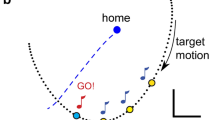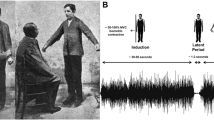Summary
A versatile tracking task has been developed to assess the competence of feline subjects in using sensory information to initiate and guide limb movement. In the present study we investigated the response latency and the factors which affect it in order to define temporal constraints on the underlying processing of information. The paradigm makes use of an electromechanical display of the difference between the output of transducers in a manipulandum (controlled by the cat) and a target level (controlled by the experimenter). Because of inertia and friction, a step change in target level required 230 msec to fully shift the display. The animals were trained to match the position of the manipulandum (or the force they applied to it isometrically) to the target level for a food reward.
Target perturbations elicited rapid position or force adjustments of appropriate direction and magnitude at short latency. Under isometric conditions, the latency of the response was an inverse function of the extent of display motion and of the peak rate of force change attained during the adjustment. Asymptotic values of the response time, measured from the perturbation to the first change in force applied to the lever, were typically between 50 and 70 msec. Since the motor responses were invariably initiated while the display was still moving, the animals must have used information contained in the derivatives of its motion. In the absence of visual cues, deflection of the vibrissae by the sudden motion of the display provided two of the four animals with sufficient information to initiate and guide their movements without changes in response latency. When vision was allowed, section of the vibrissae produced a persistent increase in response times of 15–20 msec. This difference in latency is compatible with the delays due to retinal transmission.
The short time interval elapsing between stimulus and response strongly suggests that the topography and the metrics of the underlying transformations are adjusted by gating and/or biasing processes which precede the stimulus. It is concluded that sensory information can generate purposeful movements through pathways which include only a small number of central relays in series, independently of its modality.
Similar content being viewed by others
References
Abrahams, V.C.: The physiology of neck muscles; their role in head movement and maintenance of posture. Can J Physiol Pharmacol 55, 332–338 (1977)
Bernstein, N.: The coordination and regulation of movements. Oxford: Pergamon Press 1967
Büdingen, H.J., Freund, H.-J.: The relationship between the rate of rise of isometric tension and motor unit recruitment in a human forearm muscle. Pflügers Arch 362, 61–67 (1976)
Burgess, P.R., Perl, E.R.: Cutaneous mechano-receptors and nociceptors. In: Handbook of Sensory Physiology, Vol. II (ed. A. Iggo), pp. 29–78. New York: Springer 1973
Burton, H., Loewy, A.D.: Projections to the spinal cord from somatosensory relay nuclei. J Comp Neurol 173, 773–792 (1977)
Chernikoff, R., Taylor, F.V.: Reaction time to kinesthetic stimuli from sudden arm displacement. J Exp Psychol 43, 1–8 (1952)
Crago, P.E., Houk, J.C., Hasan, A.: Regulatory actions of human stretch reflex. J Neurophysiol 39, 925–935 (1976)
Craik, K.J.W.: Theory of the human operator in control systems. I. The operator as an engineering system. Brit J Psychol 38, 56–61 (1947)
Craik, K.J.W.: Theory of the human operator in control systems. II. Man as an element in a control system. Brit J Psychol 38, 142–148 (1948)
Evarts, E.V., Tanji, J.: Gating of motor cortex reflexes by prior instruction. Brain Res 71, 479–494 (1974)
Evarts, E.V., Tanji, J.: Reflex and intended responses in motor cortex pyramidal tract neurons of the monkey. J Neurophysiol 39, 1069–1080 (1976)
Ghez, C.: Input-output relations of the red nucleus in the cat. Brain Res 98, 93–108 (1975)
Ghez, C., Kubota, K.: Activity of red nucleus neurons associated with a skilled forelimb movement in the cat. Brain Res 131, 383–388 (1977)
Ghez, C., Shinoda, Y.: Spinal mechanisms of the functional stretch reflex. Exp Brain Res (in press) (1978)
Ghez, C., Vicario, D.: The control of rapid limb movement in the cat. II. Scaling of isometric force adjustments. Exp Brain Res 33, 191–202 (1978)
Grice, G.R.: Stimulus intensity and response evocation. Psychol Rev 75, 359–373 (1968)
Hahn, J.F.: Stimulus-response relationships in first-order sensory fibers from cat vibrissae. J Physiol (Lond) 213, 215–226 (1971)
Hammond, P.H.: An experimental study of servo action in human muscular control. Third Int. Cong. on Med. Electronics, pp. 190–199 (1960)
Hochstein, S., Shapley, R.M.: Linear and non-linear spatial subunits in Y cat retinal ganglion cells. J Physiol (Lond) 262, 265–284 (1976)
Houk, J.C.: Participation of reflex mechanisms and reaction time processes in the compensatory adjustments to mechanical distrubances. In: Cerebral Motor Control in Man: Long Loop Mechanisms (ed. J.E. Desmedt), Progr. Clin. Neurophysiol., Vol. 4, Basel: Karger (in press)
Ikeda, H., Wright, M.: Receptive field organization of ‘sustained’ and ‘transient’ retinal ganglion cells which subserve different fuctional roles. J Physiol (Lond) 227, 769–800 (1972)
Luschei, E., Saslow, C., Glickstein, M.: Muscle potentials in reaction time. Exp Neurol 18, 429–442 (1967)
McGill, W.J.: Loudness and reaction time. Acta Psychol 19, 193–199 (1961)
Megaw, E.D.: Direction and extent uncertainty in step input tracking. J Mot Behavior 4, 171–186 (1972)
Melvill Jones, G., Watt, D.G.D.: Observations on the control of stepping and hopping movements in man. J Physiol (Lond) 219, 709–727 (1971)
Miller, J.M., Glickstein, M., Stebbins, W.C.: Reduction of response latency in monkeys by a procedure of differential reinforcement. Psychon Sci 5, 177–178 (1966)
Mowbray, G.H., Rhoades, M.V.: On the reduction of choice reaction times with practice. Quart J Exp Psychol 11, 16–23 (1959)
Nevas, S., Stark, L.: Sampling or intermittency in hand control dynamics. Biophys J 8, 252–302 (1968)
Nickerson, R.S.: Intersensory facilitation of reaction time: Energy summation or preparation enhancement? Psychol Rev 80, 489–509 (1973)
Phillips, C.G.: Motor apparatus of the baboon's hand. Proc Roy Soc B 173, 141–174 (1969)
Poulton, E.C.: Tracking skill and manual control. New York: Academic Press 1974
Tanji, J., Kato, M.: Recruitment of motor units in voluntary contraction of a finger muscle in man. Exp Neurol 40, 759–770 (1973)
Teichner, W.H., Krebs, M.J.: Laws of the simple visual reaction time. Psychol Rev 79, 344–358 (1972)
Teichner, W.H., Krebs, M.J.: Laws of visual choice reaction time. Psychol Rev 81, 75–98 (1974)
Schmidt, E.M.: Electronically controlled load for monkey manipulandum. Electroenceph clin Neurophysiol 35, 95–97 (1973)
Young, M.L.: Psychological studies of tracking behavior. III. The characteristics of quick manual corrective movements made in response to step-function velocity inputs. U.S. Naval Research Laboratory Report 3850, Washington, D.C. (1951)
Author information
Authors and Affiliations
Rights and permissions
About this article
Cite this article
Ghez, C., Vicario, D. The control of rapid limb movement in the cat. I. Response latency. Exp Brain Res 33, 173–189 (1978). https://doi.org/10.1007/BF00238058
Received:
Issue Date:
DOI: https://doi.org/10.1007/BF00238058




